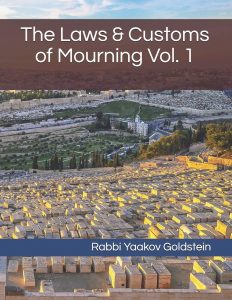
Chapter 6: The laws of Keriah and Baruch Dayan Haemes[1]
|
Overview The following is the practical order of the Keriah. Details of all these steps are expanded on in the chapter below.
Practical Seder of the Keriah and blessing of Baruch Dayan Haemes:[2] 1. The Keriah is done by the funeral/burial. 2. It is not required for one to perform Keriah to the garments he wore at the time of death and he may change to lesser quality garments for the sake of the Keriah. 3. The mourners rise and stand in a row. The custom is to position the Aveilim to the left of the corpse during the Keriah. 4. A member of the Chevra Kadisha [or any individual] makes a small starter-cut on the lapel of the jacket and/or shirt with a razor or scissor. A male member of the Chevra Kadisha is to perform it on a male mourner and a female member of the Chevra Kadisha is to perform it on a female mourner. 5. The Avel then grabs the sides that were cut and says the blessing of Baruch Ata Hashem Elokeinu Melech Haolam Dayan Haemes with Hashem’s name [if he did not say it beforehand]. 6. The Avel then completes the rest of the tearing with his hand for the length of at least one Tefach [8 centimeters]. 7. Women mourners are to have the torn area pinned together with a safety pin. 8. The torn garment is worn until after the burial, although the children of the deceased are to wear it until the end of Shiva.
Laws relating to the tear: · One is obligated to perform the Keriah in a standing position. · By an Avel for a parent, both the shirt and dress jacket [if worn] are torn. By an Avel for other relatives, only the dress jacket or only the shirt [if the Avel does not wear a dress jacket] is torn. · The tear is made in the area that is parallel to the biceps and is to tear through the border area of the garment until the torn area of the garment splits into two parts. One is to tear the garment in its length and not in its width. · The custom is that one who is an Avel for the passing of a mother or father tears the left side of his clothing and one who is a mourner for other relatives, such as for the passing of a sibling or child r”l, tears the right side of the clothing. · One who is mourning other relatives must tear a Tefach [8 centimeters] worth of the clothing. One who is in mourning for a father or mother must tear a Tefach and more until his heart [or undershirt] is revealed. · One who is mourning other relatives is to perform the Keriah in private, not in the presence of other people. However, one who is in mourning for a father or mother must perform the Keriah in public, in front of others. · One who is mourning other relatives, may perform the tear either with his hands or with the help of a vessel [such as a knife or scissor]. However, one who is in mourning for a father or mother must perform the Keriah with his hands. The custom is for the Chevra Kadisha to begin the Keriah with a scissor and then have the mourner perform the rest of the Keriah. · It is forbidden throughout the Shiva for male mourners to attach the torn parts of their garment together with a safety pin. Women are to immediately close the torn parts with a safety pin after the Keriah is done. · After the Shiva is complete, one may dispose the torn garment.
Do we follow the lenient opinion in the laws of Keriah?[3] The rule of following the lenient opinion in Aveilus does not apply towards the laws of Keriah.
|
________________________________________
[1] See Gesher Hachaim 4
[2] Nitei Gavriel 56:2
[3] Moed Katan 26b; Gilyon Maharsha 340:1



Leave A Comment?
You must be logged in to post a comment.